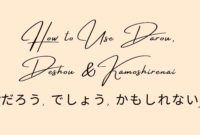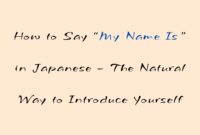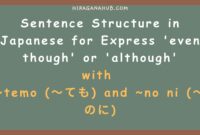Stating “BUT” with ~kedo (~けど) and ~ga (~が) in Japanese
In this article, we will learn about two Japanese conjunctions used to express “but,” namely kedo (けど)andga (が). Previously, we learned conjunctions meaning
“because” such as から and ので, as well as
conjunctions meaning “although” and “even though” like
ても and のに. Now, let’s focus on how to
use kedo and ga.
Stating a Contradiction with ~kedo (~けど)
When broken down, the pattern ~kedo (~けど) is quite simple. The word けど (kedo) is used between two
sentences that contradict each other, connecting cause and effect.

Here is the basic structure for using ~kedo (~けど):
Sentence 1 + kedo + Sentence 2
Example Sentence with Verb:
- 練習したけどまだできません。
- Renshuu shita kedo mada dekimasen.
- I practiced, but I still can’t do it.
Example Sentence with i-Adjective:
- 彼女は美しいけどあまり好きじゃないよ。
- Kanojo wa utsukushii kedo amari suki janai yo.
- She’s beautiful, but I don’t like her that much.
Example Sentence with Noun or na-Adjective (positive):
- 彼は変だけどとても好きです。
- Kare wa hen dakedo totemo suki desu.
- He’s strange, but I really like him.
If the first sentence ends with a noun or na-adjective, you
need to add だ (da) before けど. In polite
speech, you can replace だ with です (desu),
so だけど (dakedo) becomes ですけど (desu
kedo).
You can also replace けど with variations such as
けれど (keredo) or けれども (keredo mo) for
more formal situations.
Stating “But” with ~ga (~が)
The conjunction ga (~が) works similarly to
けど (kedo) but is more commonly used in polite speech. Note
that the が (ga) we’re discussing here means “but” and is not
the same as the particle が used in other parts of speech.
Here is the basic structure for using ~ga (~が):
Sentence 1 + ga + Sentence 2
Example Sentence with Verb:
- 友達に聞いたが知らなかった。
- Tomodachi ni kiita ga shiranakatta.
- I asked my friends, but they didn’t know.
Example Sentence with i-Adjective:
- 値段は安いが品質が悪い。
- Nedan wa yasui ga hinshitsu ga warui.
- The price is cheap, but the quality is poor.
Example Sentence with Noun or na-Adjective (positive):
- 天気は良いが風が強いです。
- Tenki wa yoi ga kaze ga tsuyoi desu.
- The weather is good, but the wind is strong.
Note:
While けど (kedo) and
が (ga) generally express contradiction between sentences,
they can also be used in contexts where the two clauses support each other. In
such cases, they can be translated as “and” in English.
Example:
- 昨日公園に行ったけどとても楽しかった。
- Kinou kouen ni itta kedo totemo tanoshikatta.
- I went to the park yesterday, and it was very fun.
Example Sentences and Vocabulary List
Example Sentence 1:
- 練習したけどまだできません。
- Renshuu shita kedo mada dekimasen.
- I practiced, but I still can’t do it.
Example Sentence 2:
- 彼女は美しいけどあまり好きじゃないよ。
- Kanojo wa utsukushii kedo amari suki janai yo.
- She’s beautiful, but I don’t like her that much.
Example Sentence 3:
- 料理は美味しいが、量が少ない。
- Ryouri wa oishii ga, ryou ga sukunai.
- The food is delicious, but the portion is small.
Vocabulary
| Kanji | Hiragana | Romaji | Meaning |
|---|---|---|---|
| 練習 | れんしゅう | renshuu | practice |
| 彼女 | かのじょ | kanojo | she/her |
| 美しい | うつくしい | utsukushii | beautiful |
| 変 | へん | hen | strange |
| 友達 | ともだち | tomodachi | friend |
| 見る | みる | miru | to see/watch |
| 安い | やすい | yasui | cheap |
| 品質 | ひんしつ | hinshitsu | quality |
| 悪い | わるい | warui | bad/poor |
| 今日 | きょう | kyou | today |
| 明日 | あした | ashita | tomorrow |
| 好き | すき | suki | like |
| 勉強 | べんきょう | benkyou | study |
The sentence patterns けど (kedo)
and が (ga) are very useful for stating
contradictions or contrasts in Japanese. While both can be used to express
“but,” the main difference lies in the level of
politeness. けど is more casual,
while が is used in more polite contexts.
Understanding the differences
between けど and が will
make it easier for you to choose which one to use in conversation. Keep
practicing these sentence structures, and don’t hesitate to use them in your
daily Japanese practice!


